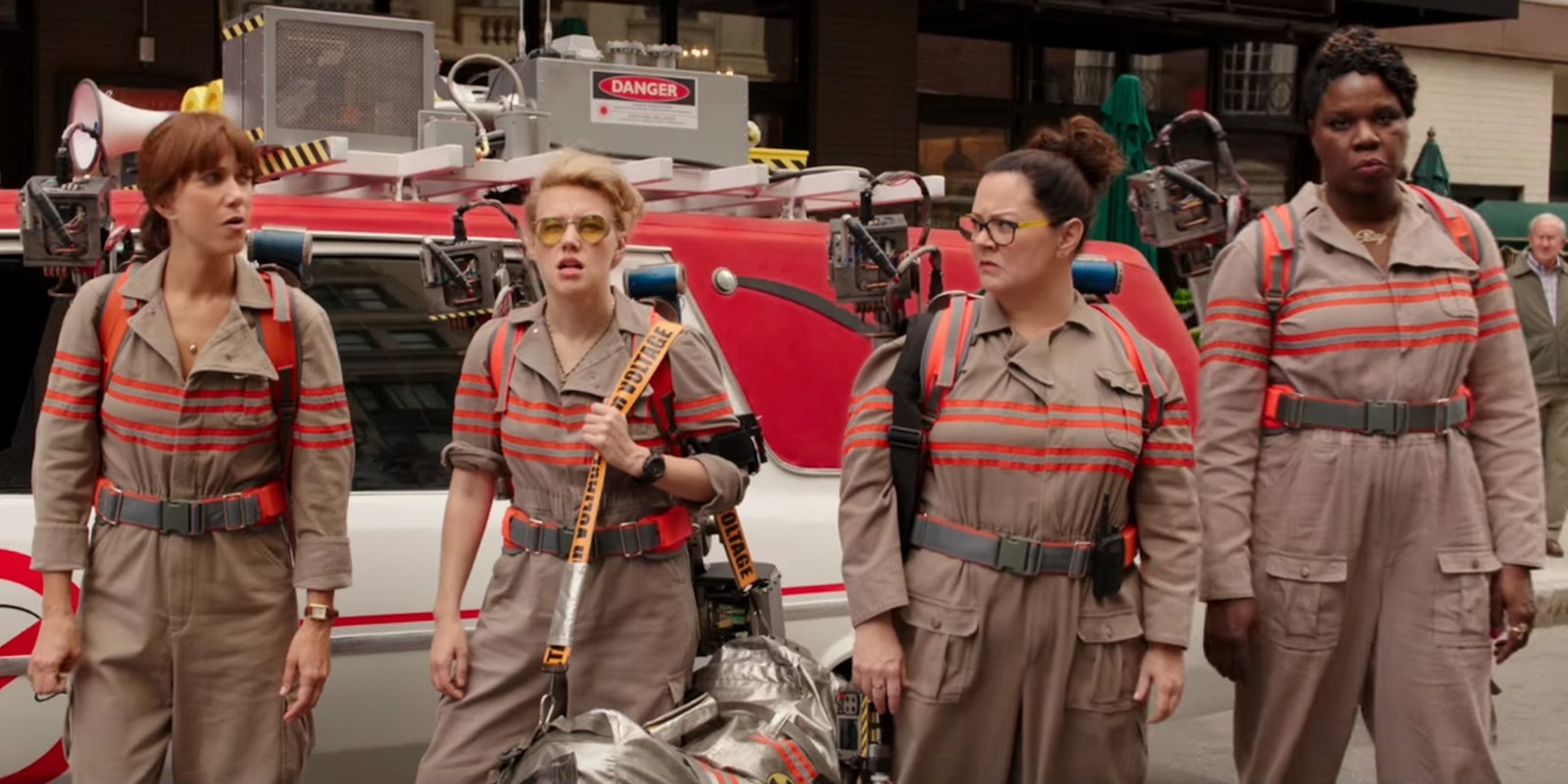Three women stand around a recording device listening to a communication from the other side. Abby, a paranormal scientist who works out of the basement of a high school, claims that her team has finally done the impossible and caught a ghost on tape. Erin, her frenemy and one-time colleague, leans in closely, not sure what to expect. A fart rings out loudly.
Jillian, a gadget-whiz who really should be working for MIT, explains that it is not what it seems. It came from the opposite end.
That’s a scene from the new Ghostbusters, a film with pleasures that are both small and revolutionary. Directed by Paul Feig from a script co-written by Katie Dippold (Parks and Recreation), its commitment to equal opportunity crassness is central to the movie’s mission statement.
In Ghostbusters, women behave in ways that are often deemed exclusive to male characters. They debate about science. They worry about their careers. They make queef jokes. Feig, who has previously directed Spy and Bridesmaids, commonly explores what it means for women to act like men. In Spy, Melissa McCarthy plays a CIA analyst who dreams of being a field agent in an industry where most spies look like Jude Law. Bridesmaids features so much scatological humor that it becomes political.
Ghostbusters, one of the funniest movies of the year, is so daffy and effervescent that it appears weightless, as if the film could float away at any moment. But that disguises its immense importance at a time when many felt it shouldn’t exist.
It’s likely even you have your mind made up about it.
The all-female reboot of the 1980s comedy classic has been one of the most intensely scrutinized movies in history. The film’s trailer is the most disliked video ever on YouTube, while Ghostbusters earned a 4.0 from IMDb users. This is despite the fact that until this week, almost no one had seen it.
In the film, Kristen Wiig (Diary of a Teenage Girl, Saturday Night Live) stars as Erin Gilbert, a professor who is up for tenure at her college. The plans are derailed when her childhood best friend (McCarthy, now a Feig regular) ropes her into investigating a local haunting. Before Erin went into university academia, the two were paranormal researchers. They even co-authored a book together. After discovering the sightings are real, the pair enlist Abby’s co-worker (Kate McKinnon), an MTA worker who has access to her uncle’s hearse (Leslie Jones), and the world’s worst male secretary (Chris Hemsworth) to fight the undead.
Ghostbusters is extremely generous to its stable of actors, each of whom is given ample opportunity to shine. Jones, a towering presence on-screen, is ferociously good as Patty, who quits her subway job for the promise of female friendship. She was under the impression the foursome was a book club and pictured them listening to Stevie Nicks together. Early reaction to the film’s trailer drew attention to the fact that the character seems to draw from an outdated stereotype—the streetwise, token black character—and that she’s the only member of the group who isn’t a scientist. But Patty, like the rest of the film, is handled with intelligence. A self-described non-fiction nerd, she’s like a walking encyclopedia.
Wiig and McCarthy, who reteam for the first time since Bridesmaids, are dependably fine as another pair of women with a complicated relationship. Wiig, who has recently carved out a niche for herself as one of cinema’s finest character actors in movies like The Skeleton Twins and Welcome to Me, wisely plays it close to the vest, showing a gift for understatement. One of the best jokes in the whole movie goes almost unnoticed: A male colleague at her university tells her she needs to rethink her wardrobe (she dresses like a physicist) and she misunderstands the edict. “Too sexy?” she asks. When she visits the Amazon page for her book, she’s pictured wearing a slight variation on the same outfit. Clearly Erin has a look.
One of the reasons that Ghostbusters works as well as it does is that its comedy is rooted in a genuine sense of character, its humor driven by a real understanding of these women’s personalities. McKinnon, SNL‘s most talented active cast member, steals every scene she’s in as a Q-like scientist with a delightfully off-kilter energy: Holtzmann is never too busy hunting ghosts to eat a potato chip or play dress-up. Appearing out of nowhere in a purple bouffant and costume shades, Holtzmann scares the daylights out of Erin. “Is it the wig or the hat?” she asks.
The plot, as tends to be the case in big-budget Hollywood blockbusters, is something of a formality. A misanthropic hotel worker who believes himself to be a genius (Neil Casey) devises an evil plan to open a portal to another dimension, thus unleashing a maelstrom of ghosts on New York City. The proceedings hew closely to the original, featuring a bevy of gratuitous cameos from members of the original crew. Some of them are groaners, but you may be too busy laughing to notice the movie’s flaws—or its smattering of plot holes. For instance, the girls are able to rent out a Chinese restaurant as their home base. How exactly is a team with no funding able to afford workspace in New York, especially if they’re too broke to get their own car?
In a year filled with failed sequels and reboots (Alice Through the Looking Glass, take a bow), it’s refreshing to see a film that is not only reverent toward its source (perhaps to a fault) but also willing to put its own distinctive stamp on the material. Like the recent Star Wars: The Force Awakens, Ghostbusters isn’t a hollow copy of its predecessor but a loving recreation, a gift to a new generation of fans. Fanboys might be worried it will ruin their childhoods, but for everyone else, Ghostbusters is a proton back blast.


